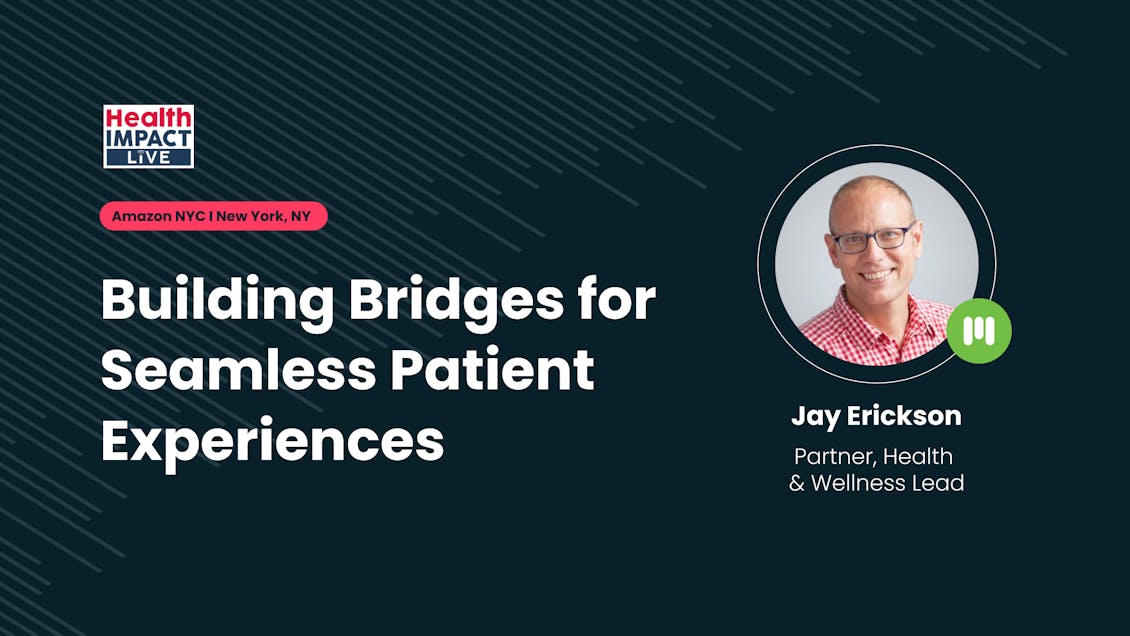Healthcare design thinking: Workshop ignites innovation on the fly

Solving patient challenges with human-centered design at HealthIMPACT Forum
Healthcare organizations face an uphill battle when it comes to digital transformation. To support its mission of using advanced technology such as AI and machine learning to improve patient outcomes, HealthIMPACT Live recently invited Modus to lead a design thinking workshop at Amazon’s New York City offices.
“Building Bridges for Seamless Patient Experiences: How Can Providers and Pharma Collaborate and Share Data to Improve Patient Support, Outcomes and Therapeutic Efficacy” was facilitated by Modus’ Chief Innovation Officer Jay Erickson along with VP of User Experience Renato Castilho.
Introduction to healthcare design thinking
The Modus team first presented the group with human-centered design thinking principles, such as the importance of first understanding problems commonly faced in healthcare environments by patients and healthcare leaders alike. Next, they showed how human need can fuel ideation and innovation, followed by prototyping, testing, and ultimately, implementation.
Participants were then broken into groups and given the following prompt to solve, applying the first few steps in design thinking (empathy and understanding followed by ideation):
How can providers and pharma collaborate and share data to improve patient support, outcomes, and therapeutic efficacy?
The ideas that emerged reflected the diversity of the individual participants as they brought their unique healthcare insights and perspectives to the challenge. The groups worked collaboratively to imagine how technology and design could solve for some of the simplest as well as more complex issues they faced.

Here are some of the highlights:
To solve the disconnect between patients, providers, and pharma when it comes to patient needs:
Create working groups between providers and pharma to explore their synergies while also ensuring providers check in with patients and patient advocate groups to ensure synergies there. Take what patients and providers say they need over to pharma so everyone is on the same page.
To solve for lack of medication adherence in patients with multiple chronic diseases, specifically depression and diabetes:
Have pharma and providers create focus groups in communities of underserved populations living with depression and diabetes. Use patient feedback to determine what types of educational information needs to be provided and where (e.g., subway marketing, digital advertising).
To solve for siloed, disparate sources of patient data:
Develop a unified, patient-facing, provider-facing, pharma-facing platform that acts on a global health system exchange standard, unifying all disparate data related to the patient, potentially through use of blockchain (e.g., universal identity used with every provider, drug, clinical trial).
To solve for the lack of trust and common goals between providers and pharma and lack of equity between patients:
Take patient-centric approaches, aligning goals and incentives, with providers and pharma collaborating from design stage to completion. Emphasis on real-world evidence in terms of gathering data. (Think: Disease foundations that have successfully partnered with pharma to collect large troves of data to drive development.)
To solve for patient, provider, and pharma access to a single repository of patient outcome data:
Create a product run by a third-party vendor to house data that can be accessed by a health system, for example, to treat at the right time in the right setting with the right medications. A patient or provider could search up what the outcomes are for a woman between 40 and 50 years old using Drug A. The product would allow for better feedback for patients, providers, and pharma.
To solve for the lack of infrastructure to facilitate patients getting on higher efficacy therapies faster:
Develop a data exchange solution using existing data exchange repositories to collect diagnostics on cohorts, showing whether people are getting better (or not) on a particular therapy. This would allow payors to be made whole if the therapy is not working or pharma to get additional bonuses and remain in tier one if the therapy is truly working. Bringing these worlds together would help keep funding going for pharma to create better and higher efficacy products.
Healthcare by design
At Modus we’re reimagining healthcare, bringing innovative and empathic approaches to UX and combining evidence-based behavior science with the power of digital tools and personal devices, knowing we can change real-world behaviors that make a meaningful difference in people’s health and wellness. Curious to see how our design thinking can help your business? Tell us what you’re up to.



